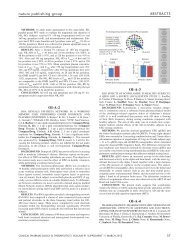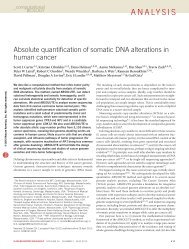open access: Nature Reviews: Key Advances in Medicine
open access: Nature Reviews: Key Advances in Medicine
open access: Nature Reviews: Key Advances in Medicine
Create successful ePaper yourself
Turn your PDF publications into a flip-book with our unique Google optimized e-Paper software.
of stroke-related death compared with those<br />
with no lesions. The location of the lesions<br />
also affected the risk of poor cl<strong>in</strong>ical outcomes:<br />
compared with <strong>in</strong>dividuals without<br />
any lesions, patients with nonlobar microbleeds<br />
had a twofold <strong>in</strong>crease <strong>in</strong> the risk of<br />
cardiovascular death, and <strong>in</strong>divi duals with<br />
probable CAA type (lobar) microbleeds had<br />
a sevenfold <strong>in</strong>crease <strong>in</strong> the risk of strokerelated<br />
death. These f<strong>in</strong>d<strong>in</strong>gs support the<br />
hypothesis that microbleeds have separate<br />
etiologies depend<strong>in</strong>g on their location <strong>in</strong><br />
the bra<strong>in</strong>, 1 and may provide an <strong>in</strong>dication<br />
for the use of anticoagulant treatment <strong>in</strong><br />
patients with these lesions—<strong>in</strong> particular,<br />
those with lobar microbleeds.<br />
The importance of detect<strong>in</strong>g microbleeds<br />
before and dur<strong>in</strong>g cl<strong>in</strong>ical trials was underl<strong>in</strong>ed<br />
<strong>in</strong> an extensive review on amyloidrelated<br />
imag<strong>in</strong>g abnormali ties (ARIA) by<br />
Sperl<strong>in</strong>g et al. for the Alzheimer’s Association<br />
Research Roundtable Work group. 6<br />
These imag<strong>in</strong>g abnormalities, seen on MRI,<br />
are thought to represent a spectrum of ‘leaky<br />
vessels’ that occur follow<strong>in</strong>g anti- amyloid<br />
immunization therapy. The work<strong>in</strong>g hypothesis<br />
was that vasogenic edema (now called<br />
ARIA-E) caused leakage only of prote<strong>in</strong>aceous<br />
fluids from the vessels, whereas<br />
microbleed<strong>in</strong>g—under the new umbrella<br />
term ARIA-H (for hemorrhage)—caused<br />
more-extensive leak<strong>in</strong>ess of the vessels<br />
that allowed blood cells to cross the blood–<br />
bra<strong>in</strong> barrier. For patients <strong>in</strong> cl<strong>in</strong>ical trials,<br />
the presence of microbleeds at basel<strong>in</strong>e<br />
may be a risk factor for develop<strong>in</strong>g ARIA,<br />
<strong>Key</strong> advances<br />
■ Lobar microbleeds <strong>in</strong> patients with<br />
dementia were found to be associated<br />
with high amyloid burden 3<br />
■ Microbleeds were shown to have<br />
different etiologies and associated risk<br />
of mortality on the basis of their location<br />
<strong>in</strong> the bra<strong>in</strong> 5<br />
■ New term<strong>in</strong>ology for amyloid‑related<br />
imag<strong>in</strong>g abnormalties (ARIA) and a<br />
new cut‑off po<strong>in</strong>t for microbleeds <strong>in</strong><br />
participants of amyloid‑modify<strong>in</strong>g cl<strong>in</strong>ical<br />
trials were <strong>in</strong>troduced 6<br />
■ Susceptibility‑weighted imag<strong>in</strong>g showed<br />
enhanced sensitivity for detect<strong>in</strong>g<br />
microbleeds compared with gradient‑<br />
echo imag<strong>in</strong>g, and may help <strong>in</strong> future<br />
for identify<strong>in</strong>g associations between<br />
microbleeds and cl<strong>in</strong>ical outcomes 7<br />
■ Studies that compared imag<strong>in</strong>g with<br />
histopathology of microbleeds suggest<br />
that further ref<strong>in</strong>ement of imag<strong>in</strong>g<br />
techniques is required to accurately<br />
detect these lesions 8<br />
as the number of lobar lesions is assumed<br />
to correlate with the presence and severity<br />
of CAA.<br />
Given the uncerta<strong>in</strong>ty regard<strong>in</strong>g the risk<br />
of ARIA and concerns about CAA severity,<br />
Sperl<strong>in</strong>g et al. recommended a cut-off value<br />
for the exclusion of participants <strong>in</strong> trials of<br />
amyloid-modify<strong>in</strong>g therapies for AD at four<br />
microbleeds. 6 This new guidel<strong>in</strong>e allows for<br />
variability <strong>in</strong> imag<strong>in</strong>g measurements and<br />
reflects the uncerta<strong>in</strong>ty regard<strong>in</strong>g the cl<strong>in</strong>ical<br />
relevance of small numbers of microbleeds.<br />
The authors further stated that occurrence of<br />
new asymptomatic microbleeds <strong>in</strong> patients<br />
dur<strong>in</strong>g trials should not auto matically disqualify<br />
them from receiv<strong>in</strong>g further treatment;<br />
however, ow<strong>in</strong>g to a lack of data,<br />
no exact cut-off for dis qualification could<br />
be given. As the authors stressed, count<strong>in</strong>g<br />
of microbleeds is not an exact science,<br />
and the uncerta<strong>in</strong>ty is further complicated<br />
by the vary<strong>in</strong>g sensitivities of different MRI<br />
techniques for detect<strong>in</strong>g these lesions.<br />
Report<strong>in</strong>g <strong>in</strong> Stroke <strong>in</strong> May 2011, Goos<br />
et al. 7 compared conventional gradient-echo<br />
imag <strong>in</strong>g with SWI to detect microbleeds <strong>in</strong><br />
140 patients from a memory cl<strong>in</strong>ic, and<br />
also to determ<strong>in</strong>e whether microbleeds<br />
were associated with patient and cl<strong>in</strong>ical<br />
characteristics. As expected, use of the<br />
more-advanced SWI technique enabled<br />
identi fication of patients with microbleeds<br />
with a greater sensitivity than could be<br />
achieved with gradient-echo imag<strong>in</strong>g (40%<br />
versus 23%). SWI also detected a higher<br />
num ber of microbleeds per patient than<br />
did gradient-echo imag<strong>in</strong>g. However, the<br />
corre lation between lesion numbers, cl<strong>in</strong>ical<br />
out comes and other radiological outcomes<br />
was limited. The cl<strong>in</strong>ical relevance of microbleeds<br />
will probably depend more on their<br />
location and size, than on the total number<br />
of lesions per se. The authors concluded,<br />
therefore, that although new imag<strong>in</strong>g techniques<br />
can show a higher number of lesions,<br />
conventional imag<strong>in</strong>g methods can already<br />
detect the majority of cl<strong>in</strong>ically relevant<br />
lesions. New imag<strong>in</strong>g methods might help<br />
<strong>in</strong> identify<strong>in</strong>g any associations between<br />
lesions and cl<strong>in</strong>ical and radiological outcomes;<br />
however, these new techniques are<br />
<strong>in</strong> urgent need of validation.<br />
De Reuck et al. 8 made an <strong>in</strong>terest<strong>in</strong>g<br />
attempt to validate MRI f<strong>in</strong>d<strong>in</strong>gs with<br />
patho logy, as reported <strong>in</strong> Cerebrovascular<br />
Disorders. The researchers <strong>in</strong>vestigated<br />
20 post mortem bra<strong>in</strong>s from patients with<br />
AD with different cerebrovascular lesions.<br />
Images of 45 large sections of the cerebral<br />
hemi spheres, bra<strong>in</strong>stem and cere bellum<br />
NEUROLOGY<br />
Figure 1 | Bra<strong>in</strong> microbleeds on MRI.<br />
Numerous lobar microbleeds with spar<strong>in</strong>g of<br />
the basal ganglia and thalamus, suggestive<br />
of severe cerebral amyloid angiopathy <strong>in</strong> a<br />
71‑year‑old patient with dementia with<br />
Lewy bodies. Image obta<strong>in</strong>ed us<strong>in</strong>g<br />
susceptibility‑weighted imag<strong>in</strong>g at 3T.<br />
obta<strong>in</strong>ed us<strong>in</strong>g 7.0T T2*-weighted MRI<br />
were paired with images show<strong>in</strong>g histological<br />
detection of hematomas and microbleeds.<br />
In the cortico- subcortical regions,<br />
the sensitivity, specificity, and positive and<br />
negative predictive values of T2* imag<strong>in</strong>g<br />
to detect microbleeds were excellent.<br />
How ever, analysis of MRI alone resulted<br />
<strong>in</strong> an over estimation of microbleeds <strong>in</strong><br />
the stria tum due to the presence of iron<br />
de posits that were, <strong>in</strong> fact, not related to<br />
real hemor rhages. Furthermore, 31% of T2*<br />
hypo signals <strong>in</strong> the deep white matter were<br />
shown to be vessels filled with post mortem<br />
thrombi. Judg<strong>in</strong>g from these f<strong>in</strong>d<strong>in</strong>gs,<br />
more studies are needed before we can fully<br />
understand the correlations between MRI<br />
and pathology <strong>in</strong> patients with AD.<br />
From this selection of studies published<br />
<strong>in</strong> 2011, we can conclude that lobar microbleeds<br />
are a marker for underly<strong>in</strong>g amyloid<br />
patho logy, are associated with strokerelated<br />
mortality, and should be adequately<br />
<strong>in</strong>vesti gated <strong>in</strong> patients participat<strong>in</strong>g <strong>in</strong><br />
anti- amyloid cl<strong>in</strong>ical trials. Optimizaton<br />
of imag<strong>in</strong>g methods to detect microbleeds<br />
will be of the utmost importance,<br />
and emerg<strong>in</strong>g techni ques will need to be<br />
evaluated and calibrated us<strong>in</strong>g cl<strong>in</strong>ical and<br />
pathological correlates.<br />
VU University Medical Center, Alzheimer Center,<br />
Department of Neurology, De Boelelaan, 1118<br />
1081 HZ Amsterdam, The Netherlands<br />
(P. Scheltens, J. D. C. Goos).<br />
Correspondence to: P. Scheltens<br />
p.scheltens@vumc.nl<br />
KEY ADVANCES IN MEDICINE JANUARY 2012 | S61








